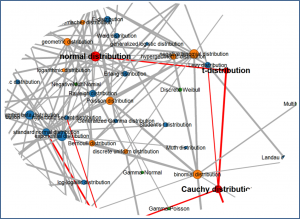Distributome Activity on Sample Sizes and the Accuracy of Polls
Introduction
 Surveys about public opinions on controversial social issues are becoming increasingly frequent as topics such as the legalization of marijuana, abortion policy, marriage rights for homosexuals, and immigration policy are hotly debated in the media.
Surveys about public opinions on controversial social issues are becoming increasingly frequent as topics such as the legalization of marijuana, abortion policy, marriage rights for homosexuals, and immigration policy are hotly debated in the media.
For example, both the Opinion Research Corporation (polling for CNN) and the Pew Research Center for The People and The Press conducted surveys of American adults in spring of 2011 to estimate the percentage of the public that favors the legalization of marijuana. The sample sizes in the two polls were 824 for the Opinion Research Corporation poll and 1504 for the Pew poll.
Goals
This activity illustrates the inter-distribution relationships between Cauchy, Student’s T and Standard Normal (Gaussian) distributions. These relationships are used to provide a better understanding of how strongly sample sizes are related to the accuracy of polls.
Hands-on Activity
In this activity you may assume that both of these pollsters use similar techniques that involve telephone interviews and weighting the answers given by individuals to align the respondents demographics with population values and finally averaging to produce unbiased and essentially normally distributed estimates. Below are 4 related, but complementary, problems regarding this study.
Note: The problems below may be appropriate for an undergraduate course in probability. The last part (Problem 4) would be more appropriate for masters level course (and should have a General Cauchy distribution tag and a tag for its relationship to the bivariate normal).
Specific Problems and their Solutions
Problem 1: Difference in Poll Accuracies?
The Pew poll had almost twice the sample size of the Opinion Research Corporation poll. What is the chance that it was more accurate than that poll for estimating p = the percentage of American adults that favored the legalization of marijuana in spring, 2011? Be sure to clearly define how you are interpreting “more accurate.” Also state and justify any assumptions you make in solving for this probability.
See a Hint
Decide on the measure of the accuracy of a poll and then evaluate \(P[\frac{Accuracy_{poll1} }{Accuracy_{poll2} } < 1]\) to gauge the chance that one poll s more accurate than the other.
See a Solution: Step 1
We want the probability that the Pew estimate based on a sample size of \(n_1=1504\), which comes closer to the true value of \(p\) than the Opinion Research poll based on \(n_2=824\) respondents. If \(\hat{p_1}\) = the estimate of \(p\) from Pew, and \(\hat{p_2}\) = the estimate of \(p\) from Opinion Research. With this notation, the problem asks for \(P(\vert\hat{p_1}-p\vert < \vert\hat{p_2}-p\vert ) \)
See a Solution: Step 2
Taking \(X \equiv \hat{p_1}-p\) and \(Y\equiv \hat{p_2}-p\), the problem statement indicates that \(X\sim N(0, \sigma_1^2)\) and \(Y\sim N(0, \sigma_2^2)\).
See a Solution: Step 3
Since the two polls use a similar methodology we may assume that the technique produces estimates with variance \(\frac{\sigma^2}{n}\) when a sample size of \(n\) is used (for \(n\) large enough for the normal approximation to be valid as in these cases).
See a Solution: Step 4
Thus, \(\frac{\sigma_1^2}{\sigma_1^2}\equiv \frac{824}{1504}\equiv 0.548\). Finally, we should assume that the estimates from the two polls are stochastically independent, which is reasonable here since they were conducted by two separate companies and the population of U.S. adults is much larger than either sample size.
See a Solution: Step 5
Now \(P(\vert X\vert < \vert Y\vert)\equiv P(-1 < \frac{X}{Y} < 1)\equiv F(1)-F(-1)\), where F is the CDF of the [http://socr.ucla.edu/htmls/dist/GeneralCauchy_Distribution.html Cauchy distribution] with scale parameter 0.548 so \(F(u)\equiv 0.5+\frac{1}{\pi}\arctan(\frac{u}{\sqrt{0.548} })\), and the answer is \(F(1)-F(-1)\equiv \frac{1}{\pi}[\arctan(\frac{1}{\sqrt{0.548} }) – \arctan(\frac{-1}{\sqrt{0.548} })]\approx 0.594.\) Many people are surprised by how low this answer is – despite having nearly double the sample size, the chance that the Pew poll is more accurate is only 0.594.
Alternative approaches
Alternative 1: Ratio of bivariate Normal variables.
See a Solution to First Problem: Alternative 1
You may solve \(P(-1 < \frac{X}{Y} < 1)\equiv P(-\frac{\sigma_2}{\sigma_1} < \frac{X/\sigma_1}{Y/\sigma_2} < \frac{\sigma_2}{\sigma_1})\)
\(\equiv P(-\sqrt{0.548}< \frac{Z_1}{Z_2} < \sqrt{0.548})\), where \(Z_1\) and \(Z_2\) are standard normal variables, and their ratio is the standard Cauchy that can then be used to get the correct numerical answer.
Alternative 2: Direct calculation of the marginal distribution
See a Solution to First Problem: Alternative 2
A second, more cumbersome, alternative is to work directly to find the marginal distribution of \(\frac{X}{Y}\) from the bivariate normal – see the solution to the last part below with \(\rho\equiv 0\).
Problem 2: Pooling Data across Polls?
Describe how you would combine the data from these two polls to form a single estimate of \(p\).
The obvious choice is to propose a linear combination of the two estimates weighting inversely proportional to the variances to get the smallest overall variance amongst such linear combinations.
See a Solution to Problem 2
\(\hat{p}\equiv \frac{1504}{2328}\hat{p_1}+\frac{824}{2328}\hat{p_2}\). Of course, this is just the estimate that comes from combining the samples into one large sample of \(n\equiv 2328\) and has variance \(\frac{\sigma^2}{2328}\).
Problem 3: Are these probability estimates correlated?
What is the correlation between your estimate above and the individual estimate produced by the Pew poll?
Note that \(Cov(\hat{p},\hat{p_1})=Cov(\frac{1504}{2328}\hat{p_1}+\frac{824}{2328}\hat{p_2}, \hat{p_1})=\frac{1504}{2328}\sigma_1^2=\frac{\sigma^2}{2328}\).
See a Solution to Problem 3
Thus, \( Corr(\hat{p},\hat{p_1})\equiv \frac{\sigma^2/2328} { \sqrt{\sigma^2(\frac{1504}{2328^2}+\frac{824}{2328^2})} \sqrt{\frac{\sigma^2}{1504} } } \equiv \sqrt{\frac{1504}{2328} } \equiv 0.8038.\)
Problem 4: Accuracy of probability estimates?
What is the probability that your combined estimate (from the second problem) is more accurate than the estimate based only on the Pew poll?
We want \(P[|\hat{p}-p| < |\hat{p_1}-p| ]\).
See a Solution to Problem 4
Taking \(X\equiv \hat{p}-p\) and \(Y\equiv \hat{p_1}-p\), then \(X\sim N(0, \frac{\sigma^2}{2328})\), \(Y\sim N(0, \frac{\sigma^2}{1504})\) and \(Corr(X,Y)\equiv 0.8038\). <br/> Hence, \(P(\vert X\vert < \vert Y\vert) \equiv P(-1< \frac{X}{Y} < 1) \equiv G(1) – G(-1)\), where G is the CDF of the generalized Cauchy distribution (see below):
\(G(u) \equiv 0.5 +\frac{1}{\pi}\arctan(\frac{u-\rho\frac{\sigma_X}{\sigma_Y} }{\frac{\sigma_X}{\sigma_Y}\sqrt{1-\rho^2} })\). <br/> So, the answer is \(\frac{1}{\pi}(\arctan(\sqrt{\frac{824}{1504} }) -\arctan(\frac{-3832}{\sqrt{1504 \times 824} }))\approx 0.613\).
Generalized Cauchy distribution CDF derivation
To derive the generalized Cauchy distribution CDF directly, we start with the bivariate normal distribution of ”X” and ”Y”:
See the Derivation of the Cauchy CDF
We start with \(f(x,y) \equiv \frac{1}{\pi\sigma_x\sigma_y\sqrt{1-\rho^2} } exp(-\frac{(x/\sigma_x)^2-2\rho xy/(\sigma_x\sigma_y)+(y/\sigma_y)^2}{2(1-\rho^2)})\).
Then the pdf of \(U\equiv \frac{X}{Y}\) is
\(g(u) \equiv \int_{-\infty}^{\infty}{\vert y\vert f(uy,y)dy}\equiv \) \(\frac{1}{\pi\sigma_x\sigma_y\sqrt{1-\rho^2} } \int_0^{\infty} {yexp(-y^2\frac{(u/\sigma_x)^2-2\rho uy/(\sigma_x\sigma_y)+(1/\sigma_y)^2}{2(1-\rho^2)})dy}\).
Since \(\int_0^{\infty}{y \exp(-ay^2)dy} \equiv \frac{1}{2a}\), we find that
\(g(u)\equiv \frac{1}{\pi\sigma_x\sigma_y\sqrt{1-\rho^2} } (\frac{1-\rho^2}{(u/ \sigma_x)^2 – 2\rho u / (\sigma_x\sigma_y) +(1/\sigma_y)^2})\equiv \) \(\equiv \frac{1}{\pi}\frac{\frac{\sigma_x}{\sigma_y}\sqrt{1-\rho^2} }{u^2-2\rho u \frac{\sigma_x}{\sigma_y} (\frac{\sigma_x}{\sigma_y})^2}.\)
Thus, \(g(u)\equiv \frac{1}{\pi}\frac{\frac{\sigma_x}{\sigma_y}\sqrt{1-\rho^2} }{(u-\rho \sigma_x / \sigma_y)^2 +(\sigma_x / \sigma_y)^2(1-\rho^2)}.\)
Finally, we know that \(\int_0^y {\frac{b}{(u-m)^2+b^2}du} \equiv \arctan(\frac{y-m}{b})\).
Therefore, the generalized Cauchy distribution CDF is
\(G(u) \equiv 0.5 +\frac{1}{\pi}\arctan(\frac{u-\rho\frac{\sigma_X}{\sigma_Y} }{\frac{\sigma_X}{\sigma_Y}\sqrt{1-\rho^2} })\).
Cauchy, Student’s T and Gaussian distribution interrelations
The Student’s T-distribution represents a one-parameter homotopy path connecting Cauchy and Gaussian Distribution:
Conclusions
Increasing the sample size may help significantly in certain situations – but not as much as intuition often suggests.






